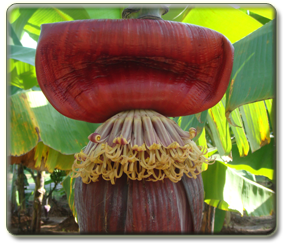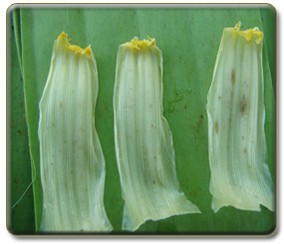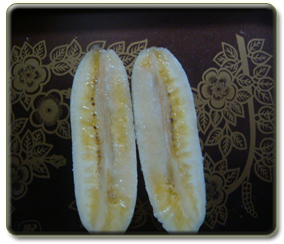Botany of Banana
Parts of the Banana
Seed
 |
-
Cultivated bananas are parthenocarpic, which makes them sterile and unable to produce viable seeds.
Root
 |
-
Fibrous adventitious root system
-
Root depth was strongly influenced by soil type and drainage
-
Positive correlation between bunch weight and quantity of roots producted.
-
Root system confined mostly to the upper 40 cm of soil because of unfavorable subsoil conditions produced less bunches.
-
No new root emissions after 75 to 90 days after planting or when 6-10 leaves had developed.
-
Root growth was best at day /night temperature of 25/18° C .
-
Extent of root growth radially and in depth was a good yield indicator.
Stem
 |
-
The real stem is underground called rhizome.
-
A single, lateral, vegetative bud which is positioned 180o C from the axil of the leaf is a generic feature
-
The apparent, unbranched, errect and areal pseudostem is formed by the long, stiff and sheathy leaf bases which are rolled around one another to form an aerial pseudostem.
-
Shaft - the central axis that is concealed at the bottom of the pseudostem.
-
At the time of flowering, the shaft elongates, pierces through the pseudostem and produces an inflorescence terminally.
-
Musa is monocorpic perennial, because it produces flowers and fruits once during its life time
Leaf
 |
-
The leaves are spirally arranged and consist of asheath, a petiole and a blade.
-
The sheaths are nearly circular and tightly packed into non woody pseudostem which is functioning as the trunk of the plant. They are much longer than the blades.
-
The petiole is rounded beneath and channeled above
-
In general, shape of the blade is blunt at the tip and tapered, rounded or even auriculate at the base. It is thickest near the mid rid and thinnest at the margins.
-
The veins of the lamina are parallel with each other.
Inflorescence
 |
-
The inflorescence is branched spadix.
-
The flowers are protected by large, brightly coloured, spirally arranged, boat shaped bracts called spathes.
-
When the flowers open, the spathes roll back and finally fall off.
-
The flowers are polygamous i.e. staminate flowers, pistillate flowers and bisexual flowers are present in the same plant.
-
The male flowers lie within the upper bracts, the female flowers within the lower bracts and the bisexual flowers within the middle bracts.
Flowers
 |
-
Flowers are placed in the axils of the bracts, arranged biseriately and commonly number about to 12 to 20 per node.
-
Basal flowers behave as pistillate flowers while the terminal ones as staminate. At the lower end, they form a bulbous male bud.
-
The axis beyond the female phase is generally bare, but in some cultivars flowers and bracts are retained.
-
The intermediate flower clusters are of transitional stage structure and are fuctionally male. Individual flowers are ebracteolate.
Perianth
 |
-
Tepals 6 arranged in two whorls of 3 each, free or united.
-
In Musa, the three tepals of the outer whorl and the two lateral tepals of the inner whorl are fused by valvate aestivation to form 5 toothed tube like structure.
-
The inner posterior tepal is alone free.
-
It is distinctly broad and membranous.
Androecium
 |
-
Basically stamens 6, in two whorls of 3 each, arranged opposite to the tepals.
-
Only 5 stamens are fertile and the inner posterior stamen is either absent or represented by a staminode.
Gynoecium
 |
-
Ovary inferior, tricarpellary, syncarpous, trilocular, numerous ovules on axile placentation.
-
The style is simple and filiform. The stigma is three lobed.
Fruit
 |
-
In edible bananas, the fruit develops by vegetative parthenocarpy i.e. the ovary develops into a mass of edible pulp without the fertilization and even without the stimulus of pollination. So the fruits are seedless.
-
In the bunch, each cluster is called hand and the individual fruit is called a finger.
-
Fruit is a berry and has a leathery epicarp, slightly fibrous mesocarp, and fleshy endocarp.
